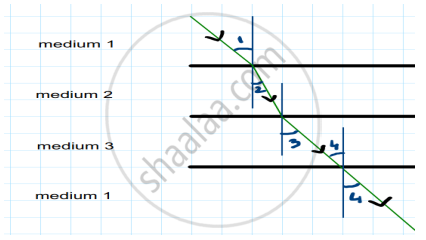Advertisements
Advertisements
प्रश्न
In refraction of light through a glass slab, the directions of the incident ray and the refracted ray are ______.
पर्याय
Perpendicular to each other.
Non-parallel to each other.
Parallel to each other.
Intersecting each other.
उत्तर
In the refraction of light through a glass slab, the directions of the incident ray and the refracted ray are parallel to each other.
Explanation:
For refraction to happen the light ray will have to incident obliquely. If the light ray is incident on the glass slab at a zero angle of incidence the ray will travel without any change of direction.
APPEARS IN
संबंधित प्रश्न
| Column I | Column II | Column III | |
| 1 | Dispersion | Long-sightedness | Twinkling of stars |
| 2 | Refraction | Splitting of white light into component colours | Convex lens |
| 3 | Hypermetropia | Change in the direction of the ray of light due to change in medium | Spectrum of seven colours |
Fill in the following blank with a suitable word:
When light is reflected, the angles of incidence and reflection are ............ .
State whether the following statement is true of false:
A student says that we can see an object because light from our eyes is reflected back by the object.
What are the important differences between looking at a photograph of your face and looking at yourself in a plane mirror?
Which type of reflection of light leads to the formation of images?
What type of reflection of light takes place from a cinema screen?
What is meant by 'reflection of light'?
A ray of light strikes a plane mirror PQ at an angle of incidence of 30°, is reflected from the plane mirror and then strikes a second plane mirror QR placed at right angles to the first mirror. The angle of reflection at the second mirror is ______.
State two effects caused by the refraction of light.
A ray of light passes from air into a block of glass. Does it bend towards the normal or away from it?
In which material do you think light rays travel faster-glass or air?
A ray of light travelling in air is incident on a rectangular glass block and emerges out into the air from the opposite face. Draw a labelled ray diagram to show the completer path of this ray of light. Mark the two points where the refraction of light takes place. What can you say about the final direction of ray of light?
Light travels more quickly through water than through glass.
If a ray of light passes from glass into water, which way will it bend : towards the normal or away from the normal?
Show the lateral displacement of the ray on the diagram.
A ray of light passes from a medium X to another medium Y. No refraction of light occurs if the ray of light hits the boundary of medium Y at an angle of:
(a) 0°
(b) 45°
(c) 90°
(d) 120°
A ray of light when passes from glass to air, bends towards the normal.
Air is optically .......... than glass.
When a ray of light travels from water to air, it bends ............. the normal.
Draw suitable diagrams to illustrate how a beam of light incident parallel to the principal axis is reflected by:
(a) a concave mirror, and (b) a convex mirror
A small air bubble in a glass block when seen from above appears to be raised because of ______.
We can see the sun even when it is little below the horizon because of ______.
Define the principal focus of a concave mirror.
What is atmospheric reflection? Explain with the help of a labelled diagram that the position of a star as seen by us is not its true position.
List four characteristics of the image formed by a concave lens of focal length 20 cm when the object is placed at a distance of 40 cm from its optical centre.
List in proper sequence the steps of the experiment for determining the approximate focal length of a given concave mirror by obtaining the image of a distant object.
Explain how the formation of a rainbow occurs.
Light changes its direction when going from one transparent medium to another transparent medium. This is called _______.
Identify the wrong figure from the following.
Explain the working of a periscope.
State whether true or false. If false, correct the statement.
The angle of deviation depends on the refractive index of the glass.
Explain with diagrams how refraction of incident light takes place from
- rarer to denser medium
- denser to rarer medium
- normal to the surface separating the two media.
The refractive index of four substances A, B, C, and D are 1.31, 1.43, 1.33, 2.4 respectively. The speed of light is maximum in

The angle of incidence from air to glass at the point O on the hemispherical glass slab is.

In the above diagram light is travelling through different media. It is noted by a scientist that ∠1= ∠3 = ∠4 but ∠2 < ∠1. Which of the following statement would be correct?
A water tank appears shallower when it is viewed from the top due to refraction.
Assertion: The air bubble shines in water.
Reason: Air bubble shines due to the refraction of light.
